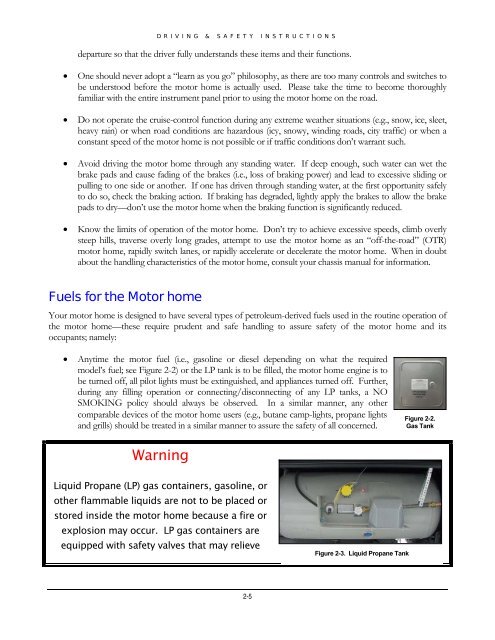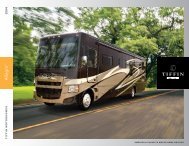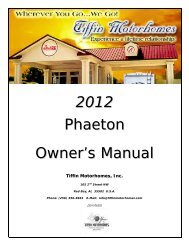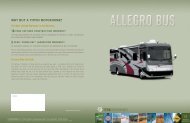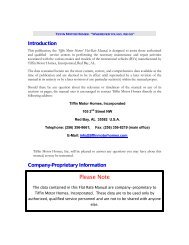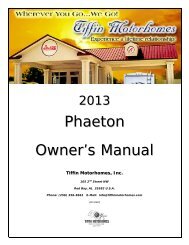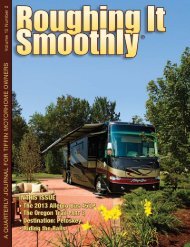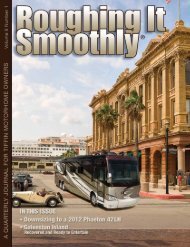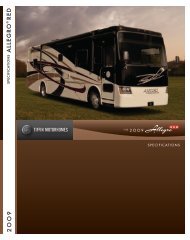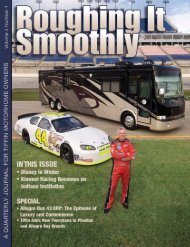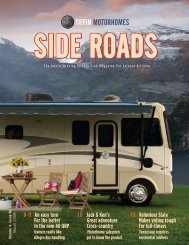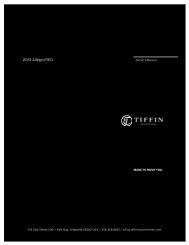Allegro Bay Owner's Manual - Tiffin Motorhomes
Allegro Bay Owner's Manual - Tiffin Motorhomes
Allegro Bay Owner's Manual - Tiffin Motorhomes
You also want an ePaper? Increase the reach of your titles
YUMPU automatically turns print PDFs into web optimized ePapers that Google loves.
DRIVING & SAFETY INSTRUCTIONSdeparture so that the driver fully understands these items and their functions.• One should never adopt a “learn as you go” philosophy, as there are too many controls and switches tobe understood before the motor home is actually used. Please take the time to become thoroughlyfamiliar with the entire instrument panel prior to using the motor home on the road.• Do not operate the cruise-control function during any extreme weather situations (e.g., snow, ice, sleet,heavy rain) or when road conditions are hazardous (icy, snowy, winding roads, city traffic) or when aconstant speed of the motor home is not possible or if traffic conditions don’t warrant such.• Avoid driving the motor home through any standing water. If deep enough, such water can wet thebrake pads and cause fading of the brakes (i.e., loss of braking power) and lead to excessive sliding orpulling to one side or another. If one has driven through standing water, at the first opportunity safelyto do so, check the braking action. If braking has degraded, lightly apply the brakes to allow the brakepads to dry—don’t use the motor home when the braking function is significantly reduced.• Know the limits of operation of the motor home. Don’t try to achieve excessive speeds, climb overlysteep hills, traverse overly long grades, attempt to use the motor home as an “off-the-road” (OTR)motor home, rapidly switch lanes, or rapidly accelerate or decelerate the motor home. When in doubtabout the handling characteristics of the motor home, consult your chassis manual for information.Fuels for the Motor homeYour motor home is designed to have several types of petroleum-derived fuels used in the routine operation ofthe motor home—these require prudent and safe handling to assure safety of the motor home and itsoccupants; namely:• Anytime the motor fuel (i.e., gasoline or diesel depending on what the requiredmodel’s fuel; see Figure 2-2) or the LP tank is to be filled, the motor home engine is tobe turned off, all pilot lights must be extinguished, and appliances turned off. Further,during any filling operation or connecting/disconnecting of any LP tanks, a NOSMOKING policy should always be observed. In a similar manner, any othercomparable devices of the motor home users (e.g., butane camp-lights, propane lightsand grills) should be treated in a similar manner to assure the safety of all concerned.Figure 2-2.Gas TankWarningLiquid Propane (LP) gas containers, gasoline, orother flammable liquids are not to be placed orstored inside the motor home because a fire orexplosion may occur. LP gas containers areequipped with safety valves that may relieveFigure 2-3. Liquid Propane Tank2-5


